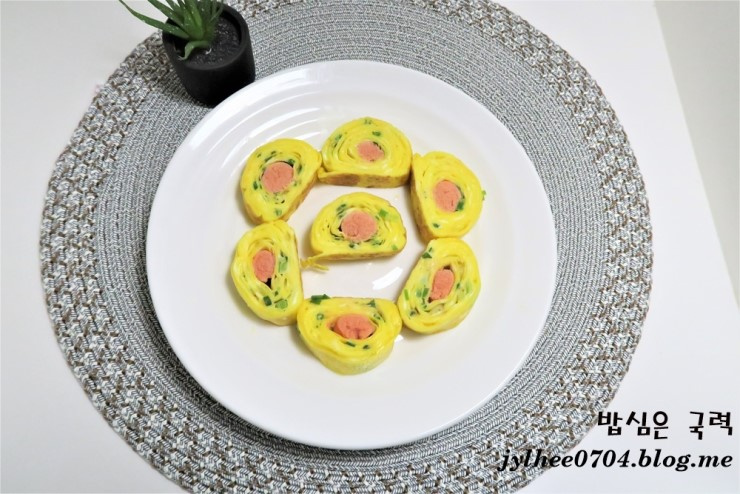Myeongran (Pollock Roe) Rolled Omelet: A Moist and Fluffy Classic Side Dish
Manmulsang Myeongran Rolled Omelet Recipe

Hello! Our strength comes from our meals. Myeongran-jeot, salted and fermented pollack roe, is a delicacy that adds rich umami to our tables. Especially, low-salt aged myeongran allows us to fully appreciate its freshness and deep flavor. Today, we’ll be making a Myeongran Rolled Omelet, a recipe from Chef Kim Sun-young featured on ‘Manmulsang’. The delightful combination of savory myeongran and tender egg is a perfect match for rice. If you’re looking for a delicious and satisfying side dish, pay close attention to this recipe!
Ingredients- 1 Myeongran (pollock roe) (or 2 if small)
- 5 Fresh eggs
- 1 Tbsp Potato starch
- 2 Tbsp Cold water
- 3 Scallions
- 1 Tbsp Cooking wine (e.g., Mirin)
- A little Cooking oil (e.g., grapeseed oil) for pan-frying
Cooking Instructions
Step 1
First, prepare the myeongran. If the myeongran is large, cut it in half. If it’s small, use two. Using white myeongran without chili powder will result in a more aesthetically pleasing omelet. Finely chop the scallions.

Step 2
Here’s a secret to making a super tender omelet! Crack the eggs into a bowl and strain them through a fine sieve. This removes the chalazae (egg white cords), resulting in a much smoother texture.

Step 3
Here is the strained egg mixture. Since the myeongran is already salty, no additional salt is added. It’s important to let the natural flavors shine.

Step 4
Add 1 tablespoon of cooking wine to the eggs to eliminate any fishy smell and mix well. Next, in a separate small bowl, combine 1 tablespoon of potato starch with 2 tablespoons of cold water to create a starch slurry. Adding potato starch directly to the eggs can cause lumps, so it’s best to dissolve it in water first. As this mixture heats up, the starch will thicken, helping the egg bind together and become more cohesive, preventing the omelet from tearing.

Step 5
Add the chopped scallions to the egg mixture and stir evenly. The fragrant scallions will enhance the overall flavor of the omelet.

Step 6
Now it’s time to cook the omelet. Lightly heat a non-stick pan over medium heat. Dip a paper towel in cooking oil and thinly coat the entire surface of the pan. Too much oil can cause the omelet to puff up unevenly. Start with medium heat, and once it begins to cook, reduce the heat to low. Cooking over high heat will burn the outside before the inside is cooked, so be very careful. Pour a thin layer of egg mixture into the pan. Once the bottom layer is slightly set, carefully place the myeongran on top and begin to roll it up.

Step 7
Gently push the rolled omelet to one side of the pan. Re-coat the empty space with a very thin layer of oil using a paper towel. Pour more egg mixture into the pan, and as it cooks, roll the existing omelet into the new layer. Repeat this process, adding thin layers of egg and rolling, until the omelet reaches your desired thickness. The key to a successful, non-tearing omelet is to oil the pan very lightly, almost as if there’s no oil at all, ensuring the egg mixture cooks evenly and rolls smoothly.

Step 8
By repeating these steps, you’ll create a thick, appetizing Myeongran Rolled Omelet, generously filled with pollack roe and cooked to a beautiful golden brown.

Step 9
Here’s a tip for neat slicing! Place a sheet of parchment paper on your cutting board before placing the omelet on it. This prevents any residual egg from sticking to the board, making cleanup much easier.

Step 10
Slice the omelet into bite-sized pieces. For even portions, cut it in half down the middle, then cut each half in half again, resulting in four equal pieces. You can also cut it into two or three larger pieces according to your preference.

Step 11
While we often make rectangular omelets, today we’ve followed Chef Kim Sun-young’s tip to create a slightly rounded shape. Enjoy this special Myeongran Rolled Omelet, featuring the delightful texture of soft egg and the bursts of savory myeongran – a dish loved by everyone!




